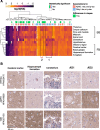Association of CSF proteins with tau and amyloid β levels in asymptomatic 70-year-olds
- PMID: 33653397
- PMCID: PMC7923505
- DOI: 10.1186/s13195-021-00789-5
Association of CSF proteins with tau and amyloid β levels in asymptomatic 70-year-olds
Abstract
Background: Increased knowledge of the evolution of molecular changes in neurodegenerative disorders such as Alzheimer's disease (AD) is important for the understanding of disease pathophysiology and also crucial to be able to identify and validate disease biomarkers. While several biological changes that occur early in the disease development have already been recognized, the need for further characterization of the pathophysiological mechanisms behind AD still remains.
Methods: In this study, we investigated cerebrospinal fluid (CSF) levels of 104 proteins in 307 asymptomatic 70-year-olds from the H70 Gothenburg Birth Cohort Studies using a multiplexed antibody- and bead-based technology.
Results: The protein levels were first correlated with the core AD CSF biomarker concentrations of total tau, phospho-tau and amyloid beta (Aβ42) in all individuals. Sixty-three proteins showed significant correlations to either total tau, phospho-tau or Aβ42. Thereafter, individuals were divided based on CSF Aβ42/Aβ40 ratio and Clinical Dementia Rating (CDR) score to determine if early changes in pathology and cognition had an effect on the correlations. We compared the associations of the analysed proteins with CSF markers between groups and found 33 proteins displaying significantly different associations for amyloid-positive individuals and amyloid-negative individuals, as defined by the CSF Aβ42/Aβ40 ratio. No differences in the associations could be seen for individuals divided by CDR score.
Conclusions: We identified a series of transmembrane proteins, proteins associated with or anchored to the plasma membrane, and proteins involved in or connected to synaptic vesicle transport to be associated with CSF biomarkers of amyloid and tau pathology in AD. Further studies are needed to explore these proteins' role in AD pathophysiology.
Keywords: AD pathophysiology; Affinity proteomics; Brain-enriched proteins; CSF markers; Multidisciplinary epidemiological studies; Preclinical Alzheimer’s disease.
Conflict of interest statement
HZ has served at scientific advisory boards for Denali, Roche Diagnostics, Wave, Samumed and CogRx, has given lectures in symposia sponsored by Fujirebio, Alzecure and Biogen, and is a co-founder of Brain Biomarker Solutions in Gothenburg AB, a GU Ventures-based platform company at the University of Gothenburg. KB has served as a consultant or at advisory boards for Abcam, Axon, Biogen, Lilly, MagQu, Novartis and Roche Diagnostics and is a co-founder of Brain Biomarker Solutions in Gothenburg AB (BBS), which is a part of the GU Ventures Incubator Program.
Figures




Similar articles
-
Longitudinal structural cerebral changes related to core CSF biomarkers in preclinical Alzheimer's disease: A study of two independent datasets.Neuroimage Clin. 2018 Apr 16;19:190-201. doi: 10.1016/j.nicl.2018.04.016. eCollection 2018. Neuroimage Clin. 2018. PMID: 30023169 Free PMC article.
-
Cognitive Performance and Cerebrospinal Fluid Markers in Preclinical Alzheimer's Disease: Results from the Gothenburg H70 Birth Cohort Studies.J Alzheimers Dis. 2021;79(1):225-235. doi: 10.3233/JAD-200751. J Alzheimers Dis. 2021. PMID: 33216028
-
Longitudinal Cerebrospinal Fluid Biomarker Changes in Preclinical Alzheimer Disease During Middle Age.JAMA Neurol. 2015 Sep;72(9):1029-42. doi: 10.1001/jamaneurol.2015.1285. JAMA Neurol. 2015. PMID: 26147946 Free PMC article.
-
Amyloid beta protein and tau in cerebrospinal fluid and plasma as biomarkers for dementia: a review of recent literature.Curr Clin Pharmacol. 2008 May;3(2):123-31. doi: 10.2174/157488408784293723. Curr Clin Pharmacol. 2008. PMID: 18700307 Review.
-
Advantages and disadvantages of the use of the CSF Amyloid β (Aβ) 42/40 ratio in the diagnosis of Alzheimer's Disease.Alzheimers Res Ther. 2019 Apr 22;11(1):34. doi: 10.1186/s13195-019-0485-0. Alzheimers Res Ther. 2019. PMID: 31010420 Free PMC article. Review.
Cited by
-
Multiple Transcriptomic Analyses Explore Potential Synaptic Biomarker Rabphilin-3A for Alzheimer's Disease.Sci Rep. 2024 Aug 12;14(1):18717. doi: 10.1038/s41598-024-66693-8. Sci Rep. 2024. PMID: 39134564 Free PMC article.
-
Large-scale proteome and metabolome analysis of CSF implicates altered glucose and carbon metabolism and succinylcarnitine in Alzheimer's disease.Alzheimers Dement. 2023 Dec;19(12):5447-5470. doi: 10.1002/alz.13130. Epub 2023 May 22. Alzheimers Dement. 2023. PMID: 37218097 Free PMC article.
-
Mapping the Genetic-Imaging-Clinical Pathway with Applications to Alzheimer's Disease.J Am Stat Assoc. 2022;117(540):1656-1668. doi: 10.1080/01621459.2022.2087658. Epub 2022 Jul 19. J Am Stat Assoc. 2022. PMID: 37009529 Free PMC article.
-
A panel of CSF proteins separates genetic frontotemporal dementia from presymptomatic mutation carriers: a GENFI study.Mol Neurodegener. 2021 Nov 27;16(1):79. doi: 10.1186/s13024-021-00499-4. Mol Neurodegener. 2021. PMID: 34838088 Free PMC article.
-
Methods to Discover and Validate Biofluid-Based Biomarkers in Neurodegenerative Dementias.Mol Cell Proteomics. 2023 Oct;22(10):100629. doi: 10.1016/j.mcpro.2023.100629. Epub 2023 Aug 7. Mol Cell Proteomics. 2023. PMID: 37557955 Free PMC article.
References
-
- Khoonsari PE, Shevchenko G, Herman S, Remnestal J, Giedraitis V, Brundin R, et al. Improved differential diagnosis of Alzheimer’s disease by integrating ELISA and mass spectrometry-based cerebrospinal fluid biomarkers. J Alzheimers Dis. 2019;67(2):639–651. doi: 10.3233/JAD-180855. - DOI - PMC - PubMed
Publication types
MeSH terms
Substances
LinkOut - more resources
Full Text Sources
Other Literature Sources
Medical

